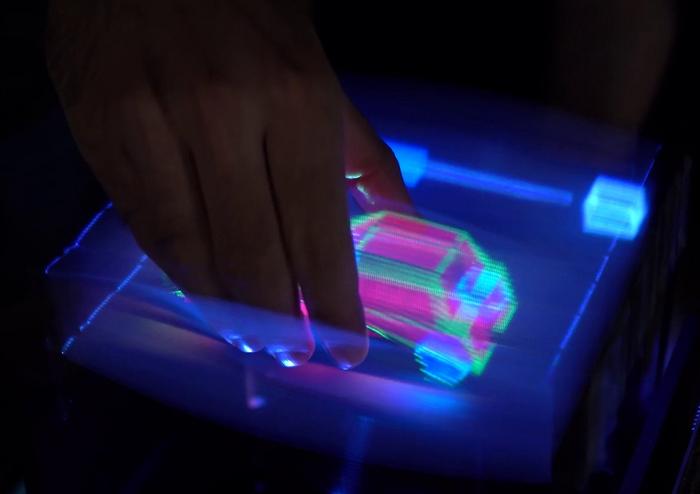Science fiction becomes reality as researchers have developed the world’s first interactive holograms that users can physically touch, grab, and manipulate with their bare hands.
A team from Spain’s Public University of Navarra (UPNA) has created a breakthrough volumetric display system that allows people to reach through floating 3D images and interact with them naturally – without special gloves or virtual reality headsets.
“What we see in films and call holograms are typically volumetric displays,” says Dr. Elodie Bouzbib, the first author of the work. “These are graphics that appear in mid-air and can be viewed from various angles without the need for wearing virtual reality glasses. They are called true-3D graphics.”
The innovation, which will be presented at the prestigious CHI 2025 conference in Yokohama next month, overcomes a fundamental limitation of existing volumetric displays – their inability to be touched.
“Commercial prototypes of volumetric displays already exist, such as those from Voxon Photonics or Brightvox Inc., but none allow for direct interaction with the holograms,” the research team points out.
Lead researcher Asier Marzo explains what makes their system revolutionary: “Being able to insert our hands to grab and drag virtual objects.” He adds: “We are used to direct interaction with our phones, where we tap a button or drag a document directly with our finger on the screen – it is natural and intuitive for humans. This project enables us to use this natural interaction with 3D graphics to leverage our innate abilities of 3D vision and manipulation.”
The technology works by projecting 2,880 images per second onto a rapidly oscillating sheet called a diffuser. Thanks to the persistence of vision – the same phenomenon that makes movie frames appear as continuous motion – these high-speed projections create the illusion of complete 3D objects floating in mid-air.
Previous volumetric displays used rigid diffusers that could break or cause injury when touched. “The problem,” notes the research team, “is that the diffuser is usually rigid, and if it comes into contact with our hand while oscillating, it may break or cause injury.”
The UPNA team’s breakthrough came from replacing this rigid component with an elastic material after extensive testing for optimal optical and mechanical properties. This seemingly simple change presented significant technical challenges, as “elastic materials deform and require image correction,” adds Bouzbib.
The potential applications extend far beyond entertainment. “Having three-dimensional graphics that can be directly manipulated has applications in education — for instance, visualising and assembling the parts of an engine. Moreover, multiple users can interact collaboratively without the need for virtual reality headsets,” explains the research team.
Public spaces could particularly benefit from this technology. “These displays could be particularly useful in museums, for example, where visitors can simply approach and interact with the content,” notes the team.
The research is part of the InteVol project led by UPNA and funded by the European Research Council (ERC), which supports the most prestigious research within the European Union.
As screens continue to dominate our lives for work, learning, and entertainment, this technology represents a significant step toward more natural and intuitive ways of interacting with digital information – bringing us closer to the seamless integration of digital and physical worlds that has long been envisioned in science fiction.
If our reporting has informed or inspired you, please consider making a donation. Every contribution, no matter the size, empowers us to continue delivering accurate, engaging, and trustworthy science and medical news. Independent journalism requires time, effort, and resources—your support ensures we can keep uncovering the stories that matter most to you.
Join us in making knowledge accessible and impactful. Thank you for standing with us!

